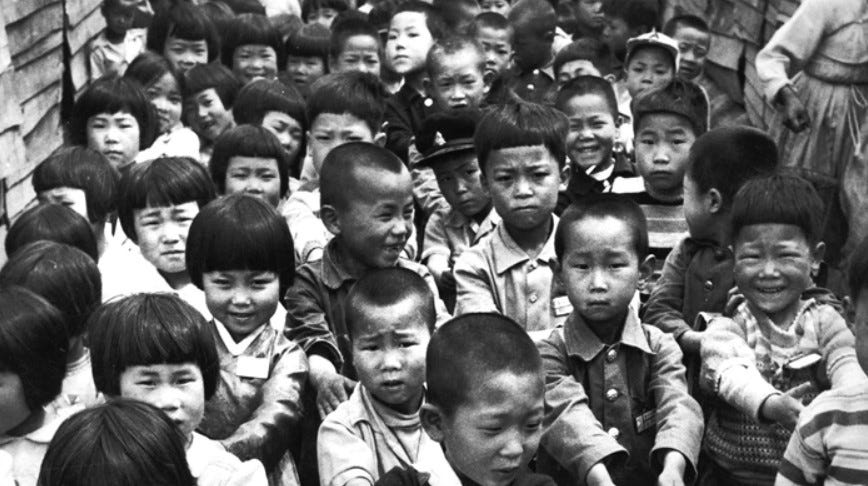
For decades, Americans largely regarded East Asians as unassimilable aliens unfit for American citizenship. The Chinese Exclusion Act of 1882 was the first American bill banning immigration of a racial or ethnic group. Thirty years later, a Japanese and Korean Exclusion League was instilled, followed by a treaty between America and Japan agreeing to deny passports to Japanese seeking employment in the US. Hatred toward the Japanese during World War II resulted in the internment of roughly 120,000 Japanese Americans.
In 1955, however, a special act of Congress allowed a white couple, Bertha and Harry Holt, to adopt eight Korean War orphans. Evangelical Christian farmers based in Oregon, the Holts ultimately inspired thousands of American families to adopt children from East Asia. Oregon Senator Richard Neuberger even hailed them as incarnations of the “Biblical Good Samaritan.” Within several decades, white Americans went from perceiving Asians as “pig-tailed coolies” to endearing children in need of American help. Christians played a pivotal role in promoting this wave of pro-adoption sentiment.
World Vision and Everett Swanson Evangelistic Association
In 1910, Japan annexed Korea. Korea was under Japanese occupation until Japan surrendered to the Allied forces in 1945. Soon after Korea gained its independence, two opposing governments split the country in two, the south supported by the United States, and the north by the Soviet Union. In 1951, North Korea invaded South Korea and war broke out. By the end of 1950, American and Chinese troops had escalated the civil war into a global conflict.
The war devastated Korea. Casualties exceeded 2.5 million people—many of them civilians, and more than 10 million people were displaced which created countless widows and orphans. By the time the war halted with an armistice in 1953, Korea was one of the most destitute nations in the world.
Disturbed by the horror of the Korean War, Robert Pierce and Everett Swanson founded World Vision and the Everett Swanson Evangelistic Association (ESEA, now Compassion International) in 1950 and 1952 respectively. Before their overseas missionary work, Pierce and Swanson had been local pastors and itinerant evangelists. Their two pioneering ministries introduced the remote “adoption” of impoverished orphans by allowing Americans to financially support children on a monthly basis and played crucial roles in transforming the image of Korean orphans from waifs and strays to beloved sons and daughters.
Many of World Vision and ESEA’s pamphlets included notes handwritten by children, such as “thank you” in broken Korean accompanied by “this is your child in the Orient” in large font. Sponsors were given an opportunity to “adopt” either a boy or a girl orphan and would receive a picture of their child, a brief biographical note, and the child’s footprint. World Vision produced numerous posters and pamphlets with the slogan “World Vision has a Korean orphan for You!” A pamphlet promoting the sponsorship program read, “You too can become the ‘dear my sponsor’ to whom they can write their touching little letters of gratitude and whose name they will remember as they say their goodnight prayers.” Pierce proclaimed that despite the physical differences between races, all children needed love.
Moreover, Pierce and Swanson helped conservative Christians integrate evangelism with social action by grafting evangelism with humanitarianism. Both World Vision and Compassion International emphasized that the foremost objective of their efforts was to bring young people to Christ. Their partnerships with orphanages were guided by evangelism, and prayers permeated their educational activities. The children themselves attended regular worship services and received ongoing discipleship.
Pierce established the “Little Shepherd Movement” which prioritized spiritual growth through Bible study and Scripture memorization. The orphanages collaborated with local Korean churches to bring spiritual guidance to more than 9,000 orphans. Pierce stated that the pictures of the children represented not just the need of individuals, but the need of humanity for hope in Christ. “By the end of the 1950s, World Vision was committing 79 percent of its annual budget to orphans, spending more than $425,000 to care for about 13,000 children,” stated a CT book review of God’s Internationalists: World Vision and the Age of Evangelical Humanitarianism. “Child sponsorships became a major part of World Vision’s fundraising and a core part of the organization’s identity.” READ MORE…
Credit: Christianity Today Magazine 2019





Wow.